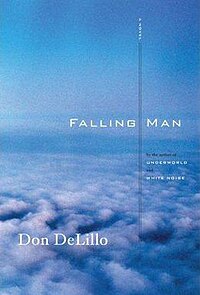Falling Man (novel)

Cover to the first edition
|
|
| Author | Don DeLillo |
|---|---|
| Country | United States |
| Language | English |
| Genre | Novel |
| Publisher | Scribner |
|
Publication date
|
2007 |
| Media type | Print (hardback) |
| Pages | 256 (Hardback first edition) |
| ISBN | |
| OCLC | 76901941 |
| LC Class | PS3554.E4425 F36 2007 |
Falling Man is a novel by Don DeLillo, published May 15, 2007. An excerpt from the novel appeared in short story form as "Still Life" in the April 9, 2007, issue of The New Yorker magazine.
Falling Man concerns a survivor of the 9/11 attacks and the effect his experiences on that day have on his life thereafter. As the novel opens, Keith Neudecker, a 39-year-old lawyer who works in the World Trade Center, escapes from the building injured slightly and walks to the apartment he previously shared with his son Justin and estranged wife Lianne. After a period of convalescence recuperating from the physical and mental trauma experienced in the attack, Keith resumes his domestic routine with Lianne while at the same time broaching a romantic relationship with a woman named Florence, another survivor, whose briefcase Keith absent-mindedly took with him from a stairwell upon exiting the tower. Lianne meanwhile grows frustrated with a neighbor in her building who loudly plays middle-eastern sounding music, witnesses the dissolution of a writing group she ran for Alzheimer's patients, and spends time with her elderly intellectual mother Nina and her boyfriend Martin (an art dealer who was involved in Kommune 1 in Germany during the 1970s). In the second half of the novel, Keith eventually abdicates his partially resumed domestic life and begins touring the world playing in professional poker tournaments full-time, recalling his weekly poker nights with co-workers, one of whose deaths he witnessed on 9/11.
Throughout the book, Lianne sees a performance artist dubbed "Falling Man" in various parts of the city. Wearing business attire, he suspends himself upside-down with rope and a harness in the pose of the man in the famous photograph of the same name by Richard Drew.
Like DeLillo's previous works, this novel is thematically concerned with the symbolic nature of terrorist violence portrayed through the mass media. In addition, Delillo's narrative examines the possibilities of reinventing individual identity as well as the tendency of individuals to construct their identities through a group mentality.
...
Wikipedia
